Do you want to translate your WordPress site into multiple languages?
WordPress powers more than 43% of all websites on the internet. Many of them serve non-English or multilingual audiences.
In this article, we will show you how to easily create a multilingual WordPress site. We will cover three different solutions, so you can choose the one that works best for you.
With each solution, you’ll be able to easily translate your WordPress posts, pages, tags, categories, and themes into as many languages as you like.
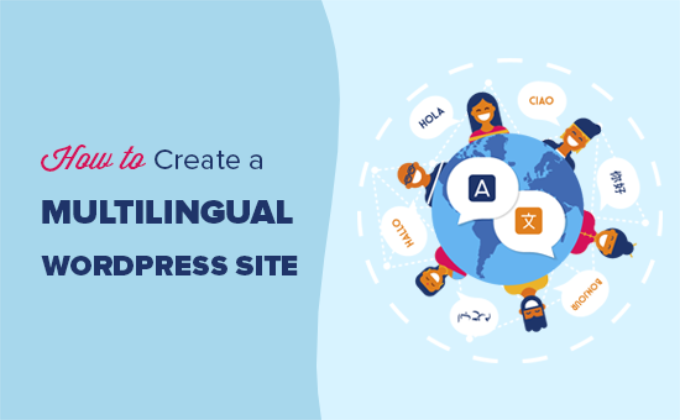
What is a Multilingual WordPress Website?
A multilingual WordPress website serves the same content in multiple languages. It can automatically redirect users to a language based on their region, or users can select their preferred language using a dropdown link.
There are a few different approaches used to create a multilingual website.
The first approach allows you to manually translate all the content into languages of your choice with the help of human translators.
The second method does not actually create a multilingual site but uses machine translations of your existing content by using auto-translate services.
However, Google Translate has stopped supporting new accounts for website translation. The other options are either not free or not very good in quality.
It goes without saying that manually translating your content is a much better approach. This allows you to maintain quality throughout your website. You can translate the content yourself or hire professionals to do that.
Getting Started with Your Multilingual WordPress Site
To create a multilingual WordPress website, you need the following items:
- A domain name (This is your website address that users will type into the search bar to visit your site, like wpbeginner.com, for example)
- WordPress hosting (This is where your website’s files are stored)
- A multilingual WordPress plugin
If you don’t have hosting or a domain name yet, we recommend using Bluehost. It’s one of the largest hosting companies in the world, and it’s officially recommended by WordPress.org.
Plus, Bluehost is offering WPBeginner users a free domain name, free SSL certificate, and 60% discount on hosting. Basically, you can get started for as low as $2.75 per month.
If you are looking for an alternative hosting solution, then we also recommend Hostinger. It also offers a free domain name, SSL certificate, and a generous discount on hosting.
After signing up for hosting, you can follow this tutorial on how to make a WordPress site for step-by-step instructions.
Choosing a WordPress Multilingual Plugin
There are several WordPress plugins that you can use to translate your website into multiple languages. You need to choose a plugin that helps you easily manage translations without making things unnecessarily difficult for your users.
In this guide, we will show you three of the top WordPress multilingual plugins with step-by-step instructions on how to set them up.
If you know which plugin you are going with, then you can directly jump to the instructions.
All three of them come with the necessary features you’ll need to make a robust multilingual website.
- They allow you to translate posts, pages, products, and other post types
- You can easily translate your categories, tags, plugins, and themes
- They allow you to set up SEO friendly URLs for each language
With that said, let’s get started.
1. Create a Multilingual WordPress Website Using TranslatePress
TranslatePress is one of the best WordPress translation plugins on the market. It is a bit different than other solutions mentioned in this guide.
Normally, multilingual plugins ask you to create multiple versions of the same article in order to translate it. TranslatePress allows you to create translations at the same time.
It also allows you to use a live editor to translate all the visual aspects of your website.
Most importantly, you can combine machine and human translations. This means you can use Google Translate or similar AI-powered tools to generate machine translations and only improve the parts that artificial intelligence missed.
The first thing you need to do is install and activate the TranslatePress plugin. For more details, see our step-by-step guide on how to install a WordPress plugin.
If you want to translate your website to more than one language, then you will also need to install the ‘Extra Languages’ add-on. You can do this from the download addons button under your account on the TranslatePress website.
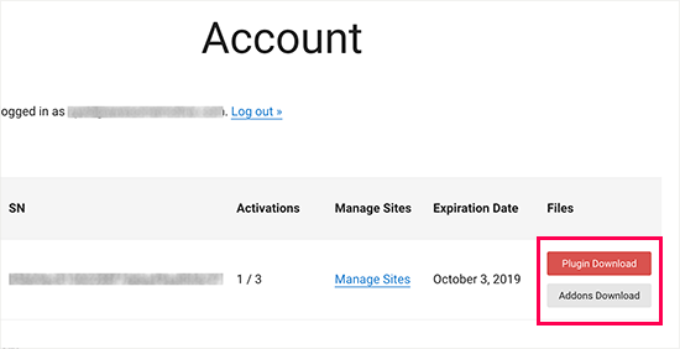
After downloading the add-on, you can install and activate it like any other WordPress plugin.
Upon activation, you need to visit the Settings » TranslatePress page to configure plugin settings.
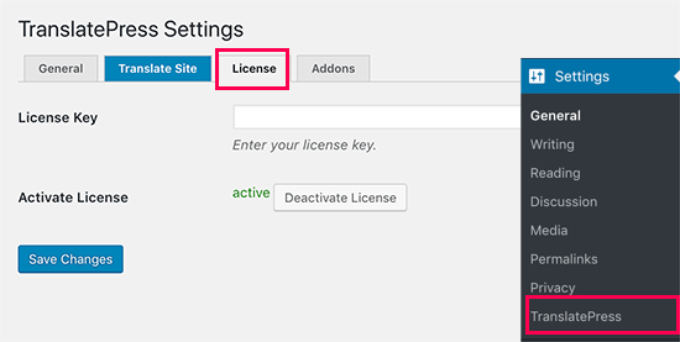
First, you need to switch to the license tab and enter your license key. You can find this information under your account on the TranslatePress website.
After that, you need to switch to the ‘General’ settings tab to set up other settings.
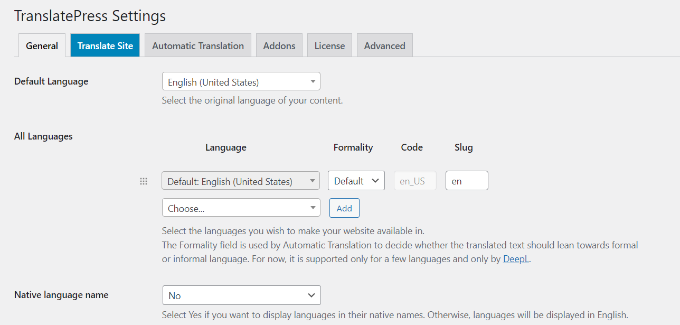
The first option on the page is to choose the default language of your website and the languages you want to translate your website into.
Next, you need to choose whether you want to display language names in the native language. The default option is ‘No’ which means language names will be shown in the default language.
After that, you need to choose whether you want to display the default language name in the URL as a subdirectory. For example, http://example.com/en/.
The default choice is no which means only the other languages will have the language name in the URL as a subdirectory. We recommend leaving this setting as-is for WordPress SEO.
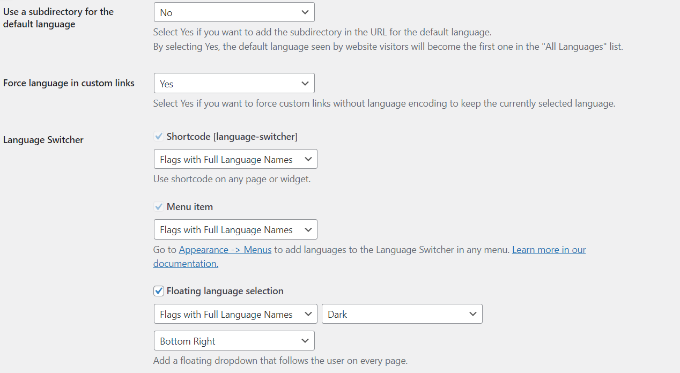
This brings you to the next setting, ‘Force language in custom links’. The default option is ‘Yes’ because that will change custom links for translated languages, making the URLs more SEO-friendly.
Next, you need to choose whether you want to use Google Translate for automatic translations. The default choice is ‘No’, but you can change that if you would like to use Google Translate.
You will need to provide a Google Translate API key in the next option. You will find a link under the option, which will show you instructions on how to get one.
Finally, you will come to the options on how you want to display the language switcher on your website. TranslatePress provides you with three choices.
You can use a shortcode, add a switcher to your navigation menu, or display a floating menu. We will show you how to add the language switcher to your website later in this article.
Go ahead and click on the ‘Save Changes’ button to store your settings.
Translating Your Website Content
To translate your website, you can simply click on the ‘Translate Site’ tab on the plugin’s settings page or the button in your WordPress admin bar.
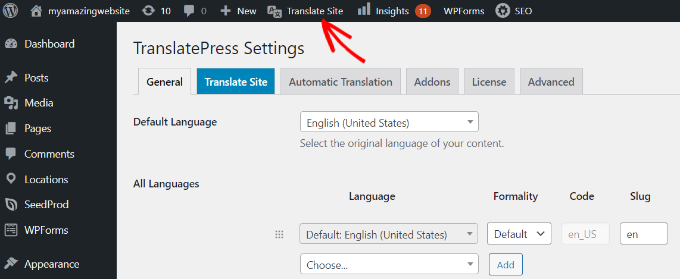
This will open the live translation editor in a new browser tab.
In this live editor, you can click on any text on your website in the right pane and TranslatePress will load it in the left column to translate.
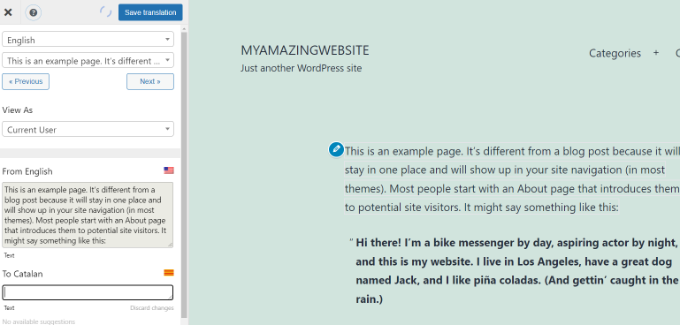
Now click on the language you want to translate the string into and then provide your translation.
After entering the translation, click the ‘Save Translation’ button on the top and then click on the ‘Next’ button. TranslatePress will automatically load the next string on the page for you to translate.
You can also just click on the drop-down menu below your default language, and it will show you the list of translatable text strings on the page. You can select a string and then provide its translation.
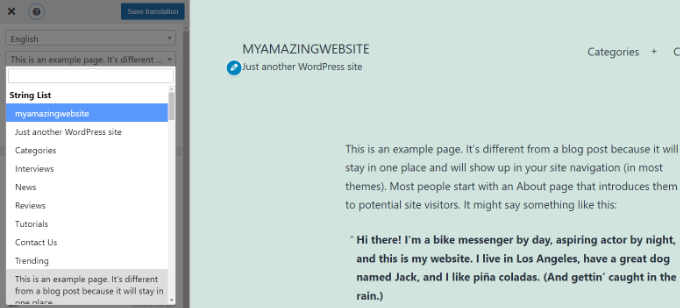
You can translate all content on any page. This includes navigation menus, buttons, sidebar widgets, meta-text, and more.
You can also visit any page by clicking on the links on the screen and start translating that page.
TranslatePress allows you to instantly translate any page or post on your site when logged in. Simply click on the ‘Translate Page’ button on the top to enter the live editor.

Once you have translated a string, the plugin will automatically translate it for you in other places. For example, if you translated a post title, then the post title in your sidebar widgets will be automatically translated.
Adding Language Switcher to Your Website
Language switcher allows your website visitors to select a language when they visit your website. It usually displays the flag of each country to indicate languages available on your site.
TranslatePress allows you to add a language switcher by using a shortcode, as a navigation menu item, or as a floating banner. The language switcher can be displayed as flags, language names, or both.
Adding language switcher in WordPress using shortcode
You just need to add [language-switcher] shortcode to posts, pages, or a sidebar widget where you want to display the language-switcher.
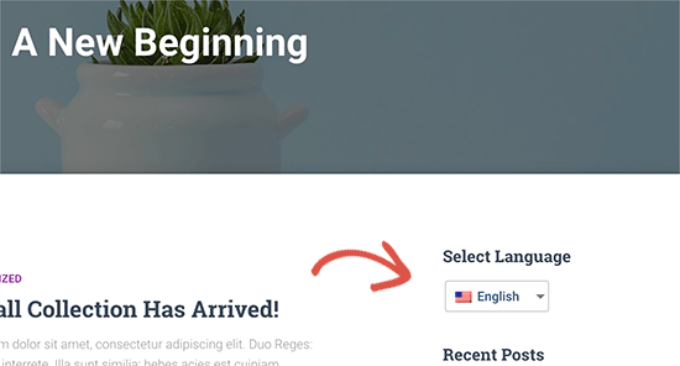
Adding a language switcher to your WordPress navigation menu
Simply go to the Appearance » Menus page and click on the ‘Language Switcher’ tab in the left column. Now select the languages you want to display and then click on add to menu button.
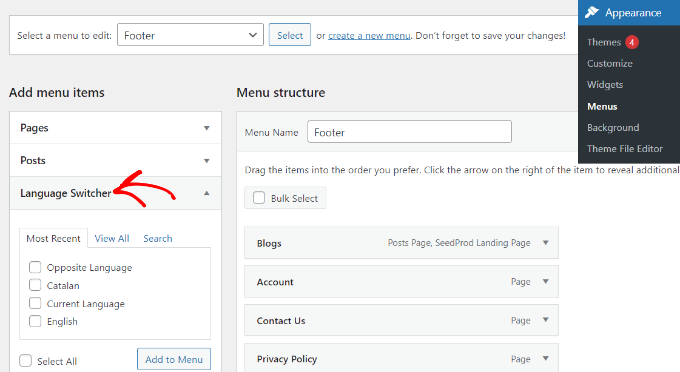
You will now see languages added to your WordPress navigation menu. Don’t forget to click on the ‘Save Menu’ button to store your changes.
This is how it looked on our test site:
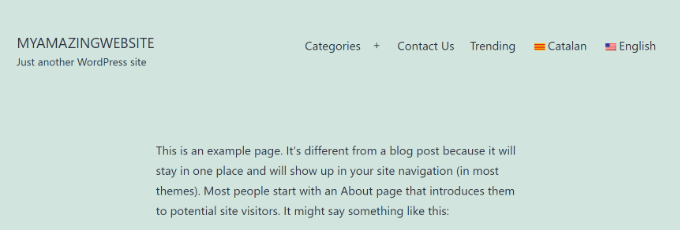
Adding a floating language switcher
Go to the Settings » TranslationPress page and head over to the General settings tab. After that, scroll down to the language switcher section.
From here make sure the box next to the ‘Floating language selection’ option is checked.
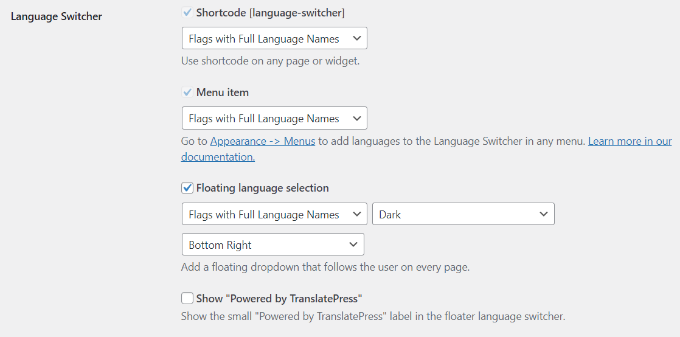
Don’t forget to save your changes.
You can now visit your website to see the floating language switcher at the bottom of every page on your website.

2. Create a Multilingual WordPress Website Using WPML
WPML (short for WordPress Multi-lingual) is one of the oldest and most popular WordPress multilingual plugins.
First, you need to do is install and activate the WPML (WordPress Multi-language) plugin. For more details, see our step-by-step guide on how to install a WordPress plugin.
Upon activation, the plugin will add a new menu item labeled ‘WPML’ in your WordPress menu. Clicking on it for the first time will take you to the plugin’s settings wizard.
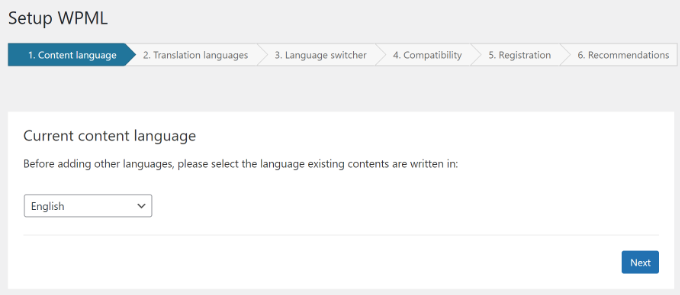
WPML will automatically detect your WordPress site’s language. You can change it here now if you want.
After that, click on the ‘Next’ button to continue.
On the next screen, you will be asked to select the languages you want to enable on your site. Simply select the languages from the list that you want to add to your site.
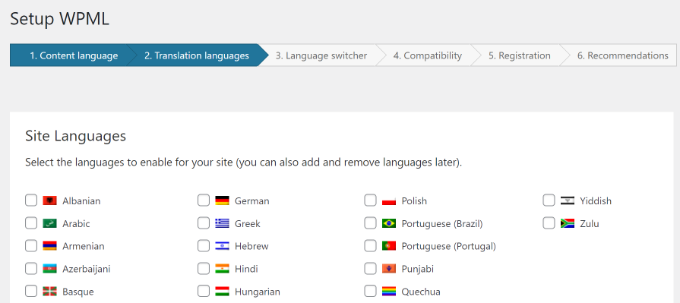
You can always add or remove languages later if you need them. Once you have selected the languages, click on the ‘Next’ button.
Now, you will be asked to add a language switcher to your site. This language switcher will allow your users to choose a language to view content in their preferred language.
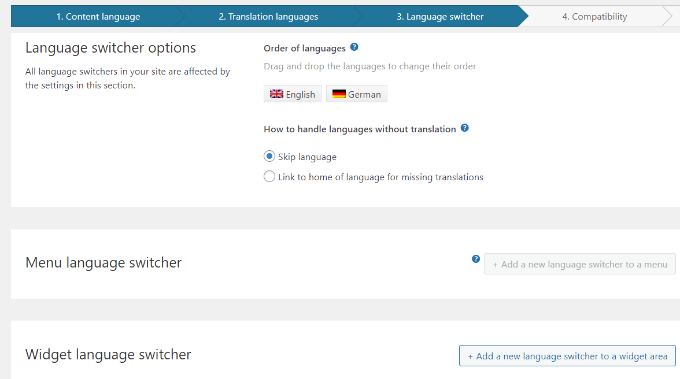
WPML allows you to automatically add a content switcher as a sidebar widget, in your navigation menu, a plain list, or in the footer area.
Next, you will be asked if you like to send a compatibility report to WPML regarding the plugin and themes you are using.
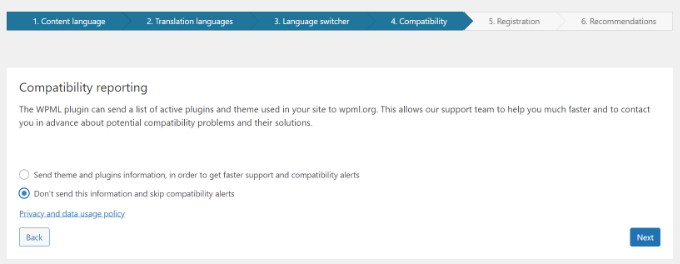
It is up to you to decide whether or not you want to send this data to WPML.
As the final step, you will be asked to enter your site key. If you have not generated one yet, then you can click on the ‘Generate a key for this site’ button.
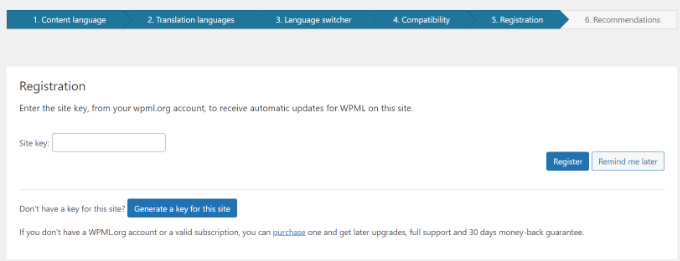
This will take you to the WPML website, where you will be asked to add the site you are coming from to your WPML account.
Once your site is added, you can click on it to get to your site key. Copy and paste this key into your WordPress site.
That’s all you have successfully finished the WPML setup wizard. You can now click on the Finish button to exit the setup.
Adding Multilingual Content into WordPress with WPML
WPML makes it really easy to translate every area of your WordPress site into multiple languages.
You will be able to easily translate your WordPress posts, pages, tags, categories, and themes into as many languages as you like.
Adding Multilingual Posts and Pages
Simply click on the posts menu to view your existing posts. You will notice the language column next to your post titles.
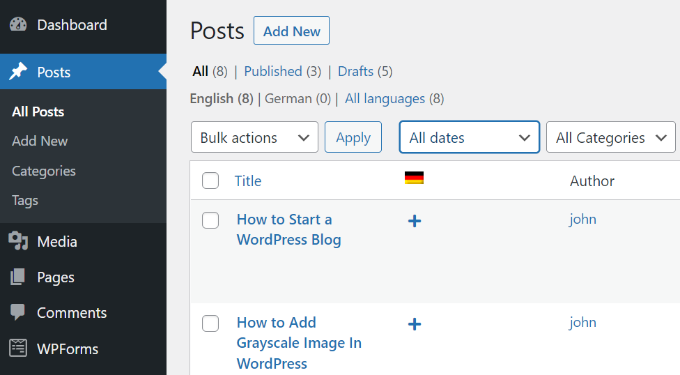
WPML assumes that your existing content is in your site’s primary language. It will show Add buttons for each language next to your posts. Click on the add button (+) under a language to translate a post.
You can also manage translations by editing a post.
On the post edit screen, you will notice the new ‘Language’ meta box to manage translations.
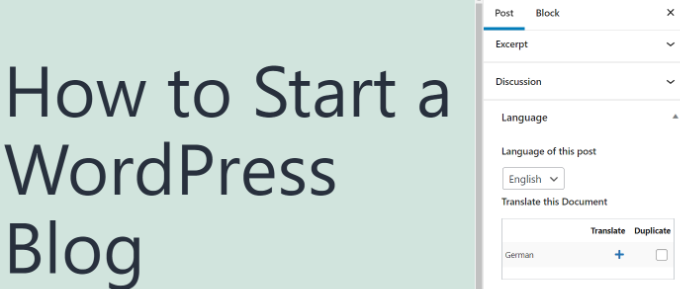
WPML also offers a better way to manage users who work as translators on your website. If you purchase their Multilingual CMS Plan, then you can use their translation management module.
The translation management module allows you to add users as translators regardless of what role they have on your WordPress site. You can even add subscribers as translators. Instead of editing posts, these translators will be able to add translations directly in WPML.
Adding Translations for Categories and Tags
WPML allows you to easily translate categories and tags, or any other custom taxonomies that you may be using.
Visit WPML » Taxonomy Translation and load the custom taxonomies you want to translate.
For example, in this screenshot, we selected categories, and it displayed all categories from our example site.
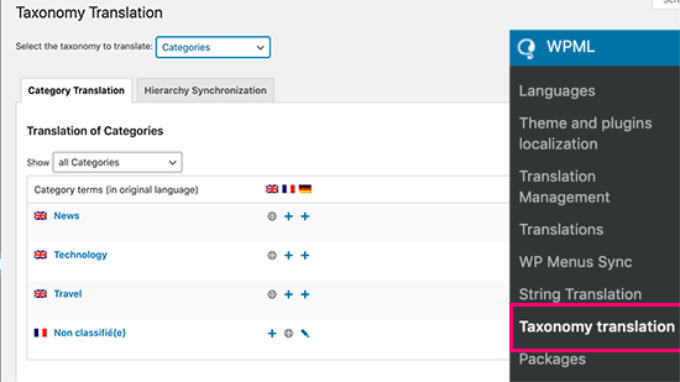
Click on the add (+) button next to the taxonomy term to add the translation.
Translating Navigation Menus
WordPress comes with a robust navigation menu system. WPML allows you to translate it just like you would translate posts or taxonomies.
Visit the Appearance » Menus page on your site. If you have more than one menu, then select the menu you want to translate.
In the right-hand column, you will see your menu with links to translate into other languages enabled on your site.
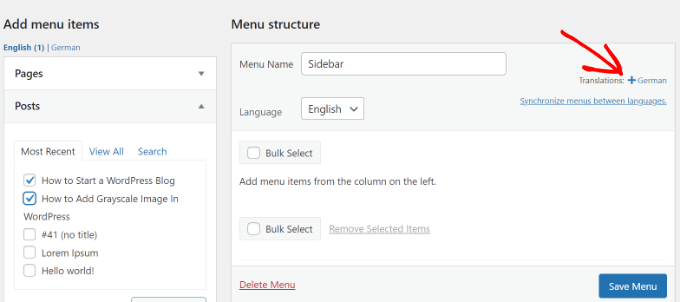
Clicking on a language will create a new menu for that language. You will need to add the same menu items as in your primary language menu.
If you have your pages and posts in navigation menus, then you will first need to translate them. After that, you can add them from the tabs on the left in the edit menu screens.
Don’t forget to click on the ‘Save’ button to save your menu.
Note: If you are using a WordPress theme that uses the full site editor, then you can edit your navigation menus under WPML » Translation Management.
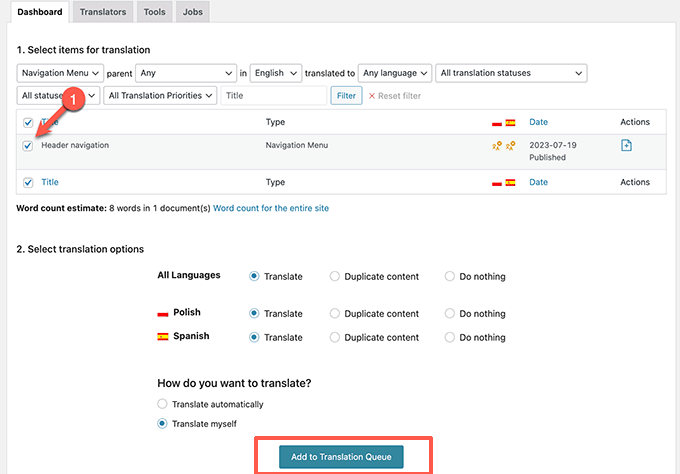
Translating Themes, Plugins, & Other Text with WPML
WPML multilingual CMS allows you to choose between official translations of themes and plugins or use its own string translator.
Go to WPML » Themes and plugins localization page.
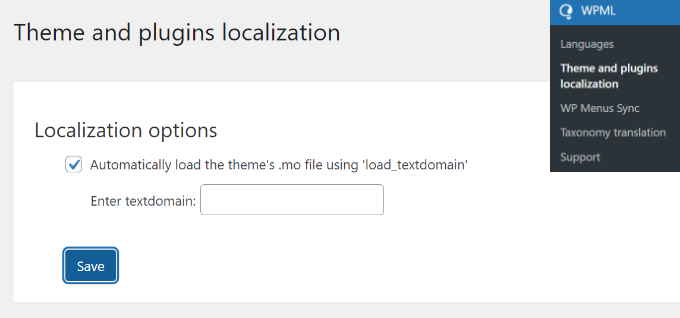
By default, WPML will look for your plugin’s translation files if they are available, and use them.
However, if your WordPress theme or WordPress plugins are not translated into the languages you are using, then you can translate them using the WPML string translation feature.
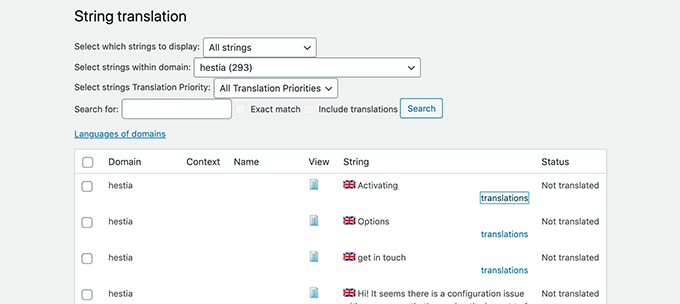
Simply scan your theme or plugin to load the strings and then start translating those strings.
This module will also allow you to translate custom fields, widgets, and other translatable strings generated by WordPress.
3. Create Multilingual WordPress Website Using Polylang
Polylang is a free WordPress multilingual plugin with more than 700,000 active installs. It allows you to easily create a multilingual website without purchasing the premium version.
Note: If you are running WooCommerce or need support, then you may want to upgrade to the Polylang Pro or purchase their WooCommerce addon.
For this tutorial, we’ll be using the free version of the plugin.
The first thing you need to do is install and activate the Polylang plugin. For more details, see our step-by-step guide on how to install a WordPress plugin.
Upon activation, you need to visit the Languages » Languages page to configure the plugin.
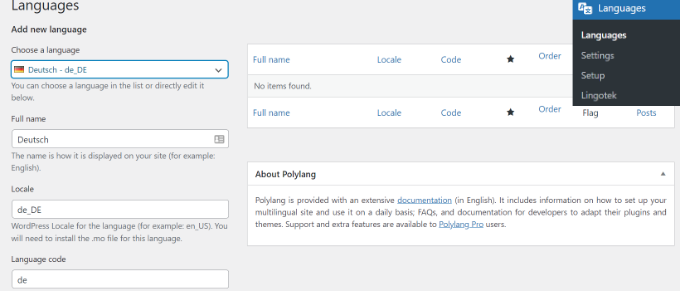
The language settings page is divided into three tabs. The first tab is labeled ‘Languages’. This is where you add the languages you want to use on your site.
You will need to add the default language, as well as select all other languages that users can choose on your site.
After adding the languages, switch to the ‘Strings Translations’ tab. Here you need to translate the site title, description, and then choose the date and time format.
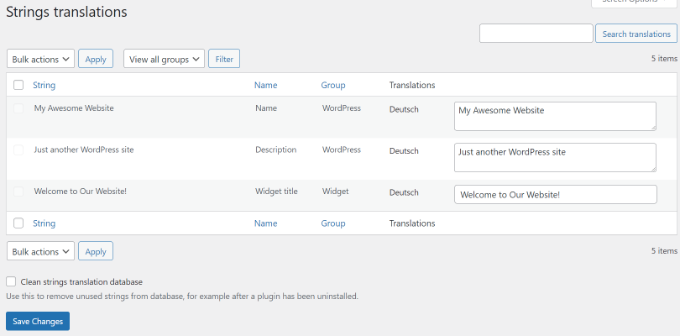
Next, you need to visit the Languages » Settings page. From here you can set the URL settings for languages and set up SEO-friendly URLs.
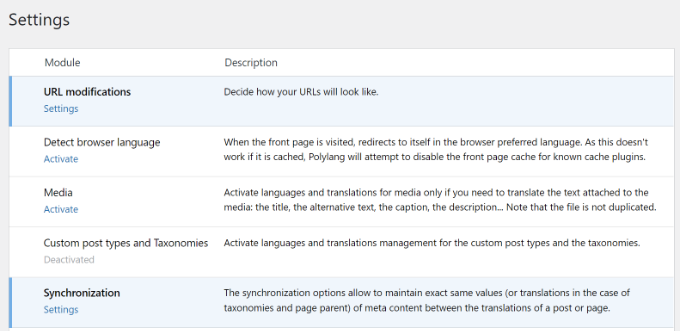
To change the URL settings, simply click the ‘Settings’ option under URL modifications. After that, you can configure your URLs and choose whether you’d like to show the language in your links.
For example, you can show URLs such as https://example.com/en/my-post/ on your website.
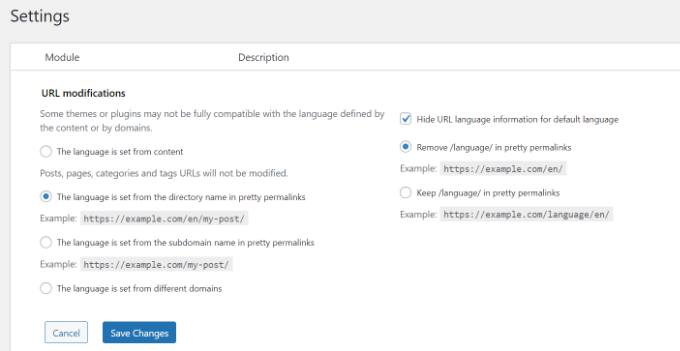
Once you are done, click on the save changes button to store your settings.
Translating Content in WordPress with Polylang
Polylang makes it super easy to add content in different languages. Simply create a new post/page or edit an existing one. On the post edit screen, you will notice the language meta box.
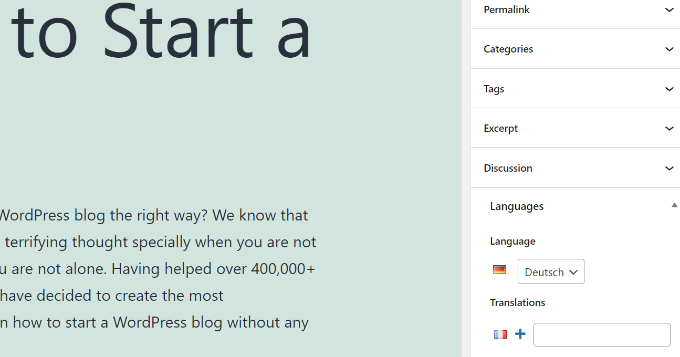
Your default language will automatically be selected, so you can first add content in your default language, and then translate it into others.
To translate, you need to click on the + button next to a language under ‘Translations’ and then add content for that language.
Repeat the process for all languages. Once you are done, you can publish your posts and pages.
Translating Categories, Tags, and Custom Taxonomies
You can also translate categories and tags, or any custom taxonomies you may be using.
If you want to translate categories, then go to Posts » Categories.
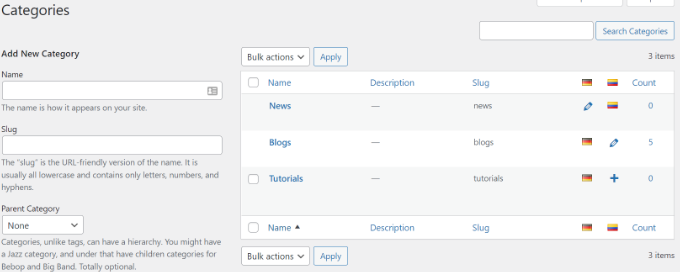
Add a category in your default language and then click on the plus icon for each language to start adding translations.
Displaying Language Switcher on Your WordPress Site
Adding a language switcher allows users to select a language when viewing your site. Polylang makes it super simple.
Just go to Appearance » Widgets and then click the ‘+’ button at the top to add the ‘Language Switcher’ widget block to your sidebar or another widget-ready area.
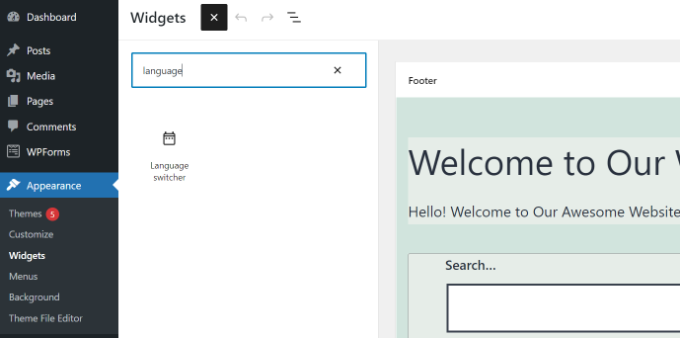
You can now enter a title for your widget, enable options for showing a dropdown, displaying language names, hiding current languages, and more.
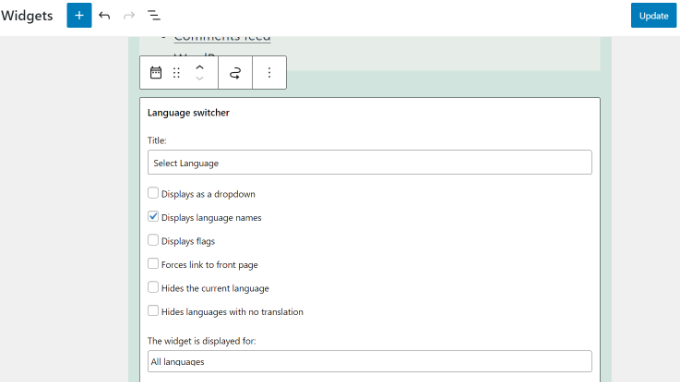
Once you are done, click the ‘Update’ button to store your widget settings.
You can now preview your site to see the language switcher in action.

FAQs About Creating a Multilingual WordPress Site
Having helped thousands of beginners start their websites, we know a thing or two about making a multilingual website. Following are some of the top questions we have been asked about multilingual WordPress websites.
1. Which WordPress multilingual plugin is the best?
All three plugins mentioned in this guide are the best. However, they are slightly different in some aspects.
If you are a beginner looking for an easier solution then we recommend using TranslatePress. Its live editor makes translations easier.
Advanced users and eCommerce websites may find WPML more comprehensive for their needs. Lastly, if you are looking for a free solution, then Polylang is the best option for you.
2. How to translate my WordPress admin area for users?
WordPress allows each user on your website to select the admin interface language. They simply need to edit their user profile and there they will find the option to select language.
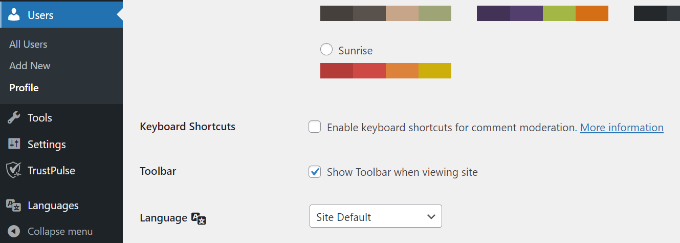
3. How do I translate my WordPress theme?
All three plugins will allow you to automatically fetch theme translations. You can also find and translate a WordPress theme by yourself and then upload translation files to your website.
4. How do I translate a WordPress plugin?
Many of the top WordPress plugins are translation-ready. However, they may not be translated into all languages. TranslatePress and WPML allow you to easily translate strings within the plugin interface.
You can also translate WordPress plugins on your own and upload the translations to your website manually.
We hope this article helped you learn how to make a multilingual WordPress site like a pro. You may also want to see our guide on how to easily get more traffic to your website and the best live chat software for small businesses.
If you liked this article, then please subscribe to our YouTube Channel for WordPress video tutorials. You can also find us on Twitter and Facebook.





Syed Balkhi says
Hey WPBeginner readers,
Did you know you can win exciting prizes by commenting on WPBeginner?
Every month, our top blog commenters will win HUGE rewards, including premium WordPress plugin licenses and cash prizes.
You can get more details about the contest from here.
Start sharing your thoughts below to stand a chance to win!
Mrteesurez says
While one can easily use Google translate as it’s easily integrated but can not be effective enough compare to translating it manually using any of the plugins you mentioned, this will makes you use any slang or jargon or keywords that is more attractive to a certain language or region.
Note that, doing it manually takes time and efforts but worth the efforts.
Jiří Vaněk says
PolyLang is a really nice plugin. I use it on the website to divide it into English and Czech versions. What’s great about this plugin is the fact that it has many extensions. The best extension is for Elementor, which allows you to display certain blocks only for a specific language. Thanks to this, the website customization is absolutely perfect and down to the last detail.
Elsie Nel says
Can I just create a duplicate of each page, change the text to another language and then add a button to switch between the two pages? Or would it cause some sort of problem that I’m missing?
WPBeginner Support says
These plugins are what add the functionality to swap with a button to easily connect the translated page.
Admin
Martin says
I’m about to purchase a subscribtion for a webhost but it only inlcude one site. Does the whole multilingual WP site with several languages count as one (1) site or does each language version counts as one (1) site?
WPBeginner Support says
If you use a plugin to add the multilingual capacity to your site then it would count as one site. If you install multiple sites and manually create the translated versions that would be multiple sites.
Admin
Masud says
How can we have different language in different subdomain.
is it possible by using plugin or need to different wordpress installation and complete different theme everything?
WPBeginner Support says
It would depend on the plugin you’re using for what options are available for subdomains, we would recommend checking with the support for the plugin you want to use for your site.
Admin
usman says
i want to create my website in Urdu. Dose WordPress have the option to create website in other language.
WPBeginner Support says
WordPress can be installed in other languages, we have a guide on this below:
https://www.wpbeginner.com/wp-tutorials/how-to-install-wordpress-in-other-languages
Admin
Ammara says
Right after activating PolyLang, Menu vanished.
WPBeginner Support says
You would want to reach out to PolyLang’s support and they should be able to assist.
Admin
jai prakash says
first time I read your complete article.
WPBeginner Support says
Glad you read our entire article
Admin
Muhammad Wasim says
I already have articles on my site indexed to google search console. If I add multilanguage support (for example it will add “en” in url for english) how can I index both language pages to google and how url change will effect the site.
WPBeginner Support says
You can hide the language in the permalink for your default language to keep those articles where they are. You would want to check with your SEO plugin to check your indexing for your site in additional languages.
Admin
Bosco says
I have a Switcher for two Languages, when I hit the default Language flag it goes top the Language Home page and everything works very well. When I select the second flag, it goes to a blank page instead of the second Language Home Page. I can however, see all the Pages on the Top bar. If I hit the Hoem page it opens and every thing else works well.
How can I make the second Flag go directly to the second Home Page? I have read of many similar issues but not seen any solutions, can anyone share a soluition with me. Thanks
WPBeginner Support says
You would want to reach out to the support for the plugin you are using currently and they should be able to assist
Admin
Gracy says
Hi, I have a Premium account on WordPress.com, but it seems I can not download plug-ins. I want my blog in two languages (manually translated). What would you recommend me to do? Thank you :).
WPBeginner Support says
You would either need their business plan or you would want to transfer to WordPress.org, you may want to take a look at our article here: https://www.wpbeginner.com/beginners-guide/self-hosted-wordpress-org-vs-free-wordpress-com-infograph/
Admin
Asmat Ullah says
which one approach is best if i manually translate each page content through google translator or install google translator plugin for better SEO
WPBeginner Support says
They should be roughly the same in terms of SEO, it would be best to have someone who knows the language translate your content for better SEO results.
Admin
Richard Montes says
When I try to dowload the Polylang pluging, the dowload button is unclicklabe and there is a note that prompts me to upgrade to the business plan. Is that how everybody here has gained access to Polylang? Is that the only way?
WPBeginner Support says
Part of your confusion is our guides are for WordPress.org sites, as you are on WordPress.com you may want to take a look at our comparison here: https://www.wpbeginner.com/beginners-guide/self-hosted-wordpress-org-vs-free-wordpress-com-infograph/
Admin
Xaric says
I have a rather complex question… I need my website translated (obviously). We are thinking about doing it with a Google automatic translator because we don’t care that much about the quality of the translation.
HOWEVER, we need some parts of the website (the categories, page titles, etc) to be manually translated by us.
So here’s my question:
Is there a way when someone changes the language of our website some of its content to be translated automatically by Google translate and the rest of it to be translated with the translation we will have set, simultaneously?
Thanks a lot in advance for your help!
WPBeginner Support says
You would want to check with the plugin you plan to use to see if that is an option with that specific plugin.
Admin
Ahmed says
how can i translate a static front page or the index???
WPBeginner Support says
With Polylang you would translate it the same as you would with other pages on your site.
Admin
Nicole says
Thank you for such a great article. This is exactly what I was looking for to translate my site from English to Spanish.
Do you know if I go with the Manual route if it will work with the Visual Composer builder (WPBakery)?
Thank you!
WPBeginner Support says
You would need to reach out to the support for Polylang to see if there are any known conflicts at the moment
Admin
Zeena Kabad says
Hi. when I use Polylang, I must make a new page to translate an existing one, this will duplicate all pages for each language, but for the product page I cannot duplicate it because the SKU must be unique also the tags I cannot use the same word for the two languages…
Can anyone help me??
Thanks
WPBeginner Support says
It would depend on what you’re using for your products. If you reach out to polylang they should be able to let you know other options with their plugin
Admin
Francisco says
I installed Polylang but it made a mess with my categories… it created separate categories for each language, which is really really not what I wanted… is there a way to make it use a certain category, independently of language?
WPBeginner Support says
You would want to reach out to Polylang for the customization options you have for your categories.
Admin
Max says
Great, but what about translating theme intself? How can we create site where texts in theme elements (not post, comments, etc. but header, footer and others) can be presented in a few languages? What should I do, make two index.php? How to attach lang switcher to site so if it once is set, all the content goes in selected language?
The main and the most important part left unclear (
WPBeginner Support says
Depending on the translation plugin you are using, there normally is a built-in method for translating the theme’s strings. If you reach out to the plugin’s support they should be able to let you know how they handle that.
Admin
Rahim says
Hi
I have an other approach and I don’t know if it can work or not : my idea is if it is possible to assign each langage to a specific name domain in the same langage. For example : hello.com for the English version and bonjour.com for the French version.
It is possible ? And how can I do that ?
Thanks for your help.
WPBeginner Support says
You would want to reach out to the support for the multilingual plugin you are planning to use and most should have a method to set that up with their plugin.
Admin
Juliana says
I added the widget, but when I write my post in the second language that I selected I am unable to use the Yoast SEO, how can I go about adding that for my second language?
WPBeginner Support says
You would likely want to reach out to Yoast’s support to ensure there isn’t a plugin conflict.
Admin
root says
Hello, my website wordpress, have 4 language:
English (en)
Albanian(sq)
Macedonian(mk)
when i open, website.com/en, my posts not showing
when i open, website.com/sq, my posts appear
WPBeginner Support says
If the settings are set for English posts to be under there you may want to try resaving your permalinks, otherwise, you may need to reach out to the plugin’s support to ensure your settings are correct.
Admin
juan says
If I install this plugin, how can I configure my SEO plugins to also be able to work on my SEO for the other language?
also…
If i install the plugin, will all my url be changed adding the language prefix /en/?
This will affect my current SEO.
WPBeginner Support says
You would want to check with your specific SEO plugin for concerns with compatibility. The plugin has the option to not change the permalink structure for your default language.
Admin
juan says
Is The plugin able to identify the user’s location and then offer the user the site in the language based on his location?
WPBeginner Support says
You would want to reach out to the plugin’s support for if they have a geolocation option for that.
Admin
Vielma says
Hello, I have set up a Multilingual WordPress Site (Human Translation) and it works fine, however the homepage I created for my second level seem to store ALL posts and pages ever created or edited. I have made sure that all pages are a static page and dont understand why this is happening. When I go to Pages -> my chosen home page in the second language and preview it looks perfect. But when typing in the url it gathers all content on my website. How do I do to remove this?
WPBeginner Support says
You would want to reach out to your multilingual plugin to let them know about this and they should be able to assist.
Admin
maryam says
hi.when i add a translate to page in my site it build another page. but i need a page with 2 translate. not seperate page. what should i do?
WPBeginner Support says
If you want the content to automatically translate without the need to create content for the other language you would want to use the Google Language Translator option from this article.
Admin
RD Prajapati says
I have a blog whose primary url is travelwithrd.com which is by default in English. But when I installed polylang for Hindi language, url of hindi version was travelwithrd.com/hindi. Now the rss feed address of hindi site also changed I think. How can I set two languages option in homepage without this subfolder type url.
WPBeginner Support says
We do not have a recommended method without changing the url for the different language, you may want to reach out to polylang with what you are wanting to see their recommendations.
Admin
Mikiyas says
Hello,
I am currently on your email list and I love the tips/advice that you guys give. I want to be able to translate one of my WordPress sites to Amharic I tried using Polylang as suggested but I was having difficulty finding the .mo Amharic files that I would need to upload to the WordPress settings.
1. Where would I find such files?
2. Once I get them where exactly do I upload them.
3. Once uploaded how do I configure Polylang to display Amharic.
Any input would help, hope to hear back soon!
WPBeginner Support says
Hi Mikiyas,
Language files are located inside languages folder in a plugin or theme’s folder. You can find them using the FTP client. You will select the language from Polylang’s settings page.
Admin
Imola says
I did everything mentioned here but then my blog appeared as I have no posts yet. When I de-activated the plugin my posts came back to normal. Any help? Thanks in advance
WPBeginner Support says
You may want to ensure you set the correct default language, if that is not the issue then you would want to reach out to the plugin’s support to ensure this is not an error with the plugin itself.
Admin
Joelsen says
It can litterary take ages to look for help on the net. That is until one stumbles accros a place like your site. In less than a couple of minutes I was runing my WordPress site in multiple languages. A BIG THANK YOU!
WPBeginner Support says
Hi Joelsen,
We are glad you found the article helpful. Don’t forget to follow us on Facebook for more WordPress tips and tutorials.
Admin
Raksha says
Hi am facing the problem that when i switch from my defualt language to other that particular page language gets changed but as sson as i switch to other page it comes back to default language page? How to do that setting
Stephanie says
Hello,
I followed the step by step for Polylang but it didn’t go well. We don’t use ecommerce and it automatically enabled that option.
How can I set up the plugin to work on the site as it is? No shopping, no cart, none of that business.
I appreciate the assistance!
Have a great day
WPBeginner Support says
Hi Stephanie,
If you don’t use these options then you can just leave them as they are. If you come across issues, please contact plugin author via support page on plugin’s website.
Admin
Nick Gillespie says
HI WPB Team (thanks for all your help!)
I see that you indicate the need to translate Date & Time. I’m translating a website from English to Russian.
In Russian, they do not indicate am or pm after a time. Within the English website, in the blog posts the time is displayed in that way.
How may I display in English am/pm and in Russian the time in 24hours?
Kind regards,
Nick
WPBeginner Support says
Hi Nick,
You can compare and see how other open source software translate AM and PM in the Russian language.
Admin
Hussain says
Thank you for informing and easy to follow post. I followed your steps and everything goes very well. However, I want to place the switcher in the main menu but I can do it my current theme (ocean WP). I manage to place it in the menu in different themes Any help is appreciated
Ehtsham Zaheer says
Hi, is any other tool or plugin for making urdu and roman urdu multilingual website?
Helene says
Hello, Can i add Polylang and then use it only to translate my posts?
Sean says
Yes, you can manually translate all your posts and pages.
Padma says
I need to convert my website and my writings into Sinhala (Sri Lanka) Language. Can I install Sinhala fonts to settings? If yes, please tell me how to do it. Thanks a lot
WPBeginner Support says
Hi Padma,
It depends, some themes allow you to select Google Fonts. If a Google Font supports your local language, then you can select it. You can also load fonts from your website by manually adding code to your theme. For detailed instructions, please see our guide on how to add custom fonts in WordPress.
Admin
Magdalena Kuprowska says
I have my blog in 2 languages using Polylang and I want all posts to be shown on front page depending on the language. How can I do that? When I had my website just in ENG I used
“Your homepage displays the latest posts” but with two languages it doesn’t work for the second language. Please help!
Karin says
Hi!
I love wpbeginner. You have very useful and well explained tutorials.
I was curious in this case why you recommend Polylang over WPML ? WPML is paid, but then you get support which seems like a good idea since any language plugin seems complex affecting theme and plugins etc.
Thanks!
WPBeginner Support says
Hi Karin,
We recommend both plugins. We feel Polylang is a little bit more beginner friendly with better user experience. We also recommend WPML, for instructions see our article on creating multilingual WordPress website with WPML.
Admin
Javed Ur Rehman says
Do you think using plugins that are not common will be safe? i mean we know that there are some most common plugins that almost everyone using. Any many people also saying that do not use plugins that do not belong to well known source.
WPBeginner Support says
Hi Javed,
You can use plugins that are not installed by many people. However, do checkout plugin reviews and support forums to see if anyone has reported a problem with the plugin.
Admin
Mohamed Nabil says
How to change my home page language and with main function menu and widget and real estate
Smiler says
I installed the plugin and everything works fine except: when I change the language into a new one (on the slider) at Home page and then click on the shop page, WP takes me to default Language Shop page.
Juinn says
My website utilises many plug-ins. So I would need LocoTranslate for the theme and plugins, and then polylang to translate each page?
WPBeginner Support says
Hi Juinn,
Yes, if the theme and plugins you are using are not already translated in the languages you want to use on your website, then you will want to translate them.
Admin
Stefano B says
I deleted a page translated with polylang.
Now I can no longer create a new translation from the original.
Do you know how to do it?
Vedra says
Hi,
We can’t seem to use this plugin to translate the header. Can you do that, if so, how?
Cheers,
Pedro says
Thank you very much for this amazing article… and this amazing site! My #1 website to learn and develop my still in progress WP blog .)
I have a question about Polylang. I tried researching on the plugin official website but I can’t find what I’m looking for. Hope you can help me!
What does Polylang do to create a multilanguage site, create a subdomain or a subdirectory? In any case, is this something the user is able to decide in the setup process?
I’ve seen there are different options to choose your URL pattern, but I’m not sure if they have anything to do with my doubt.
Thank you very much in advance!
Dias says
Thank you, it’s working fine, but the choice of flags doesn’t appear in the mobile, in the mobile menu
Ken says
How can I make translations to website like ?lang=somelanguage but not two separate pages? I would like to avaoid Google translate on my sites as Google translate sucks
Mathias says
Hi, How do I make my site in such a way that the header menu has two flags to the right of them for selecting languages? I believe that is not normally a widget area, but many sites put the flag/language option int he top right corner. How do I do that with this plugin? Thanks
WPBeginner Support says
Hi Mathias,
If you are using the Polylang plugin, then you can add language switching to navigation menu.
In appearance->menus, go in screen options on top right of you screen and check the “Language switcher” checkbox. You then should have a new metabox which allows to add a language switcher just as you add another menu item.
Admin
Alana Lopez says
Hi,
First, we have an automated email that goes out every time we post an article to our subscribers. We would now like to add translated versions to a post that has already been published – would this trigger the email to send again because of new content? Or would this work like editing a post after the it has been published – not create a new post?
We only want to apply this to one article/page at the moment – is it possible to add the translation widget to only one page?